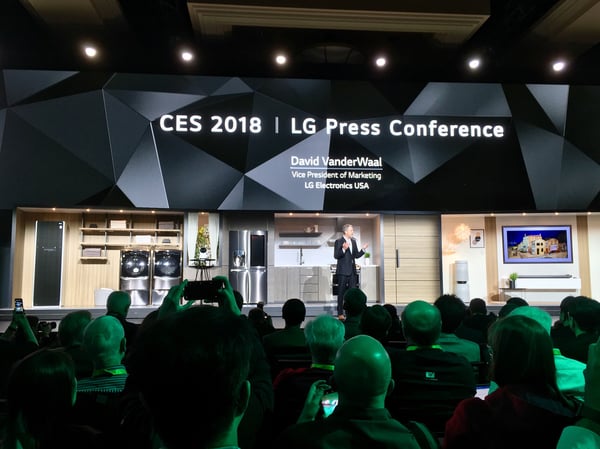Today marks the second Media Day of CES 2018, and to kick things off, LG debuted a number of new technologies at this morning's press conference.
As one might expect, the announcements leaned quite heavily toward Smart Home, with LG's ecosystem boasting a suite of abilities -- many of them AI-powered. There's the "Smart Service" feature, for instance: the technology that detects potential problems with appliances (like your washer or dryer) and proactively notifies the service center, often fixing the issue before the user even knows there is one.

It was reminiscent, for me, of many of the announcements made in October at the Samsung Developer Conference -- the idea of a unified ecosystem (LG's is called ThinQ) that's powered by machine learning solutions, all on an open platform. One of the differentiating factors announced today, for example, is LG's connectivity among home, car, and office: the type of technology that allows, for example, your refrigerator to send a message to your car notifying you if you need to go to the grocery store.
But as I was busy live-tweeting and day-dreaming about filling my home with these oh-so-smart devices, I noticed this:
A fundamental problem with #CES gadget thinking: All our things talk to each other! You just have to learn our new language and use it exclusively in your home. https://t.co/pFCQOqKItA
— Geoffrey A. Fowler (@geoffreyfowler) January 8, 2018
The flaw, Fowler points out, is the thinking that most consumers exclusively equip their homes with appliances from a single brand. It proposes a world, for example, where you don't have GE appliances in your kitchen and a Samsung TV (such as yours truly) -- you have one, single brand filling your home with everything.
LG did note that users will be able to control IoT devices manufactured by other brands from your refrigerator panel. But there enters the concept of practicality -- how often are you in standing directly in front of your fridge when you need to, for example, remotely control any other given device in your home?
Which leads me to another question: Just how far will consumers go when it comes to brand loyalty?
When it comes to the marketer's job, there are two key takeaways here. The first is to determine how -- and to begin, if -- your brand is equipped to build such an ecosystem, regardless of your industry. Are your products and services connected to complement each other and work in synergy to enhance the customer or user experience?
But building a branded ecosystem with the customer in mind is a double-edged sword. Is built in a way, for example, that if the products and services are fragmented -- for example, the customer has bought into one piece of the ecosystem, but not the whole thing -- the user experience is somehow diminished?
As marketers begin to build upon and work to stay ahead of these emerging trends and technologies -- the Internet of Things, voice search, and growing AI-powered capabilities -- these are crucial questions to ask until they are answered in a way that, without a doubt, only enhances the user experience, even if they don't or can't buy into an entire ecosystem.
That's not to say I discourage this type of connected thinking -- in fact, I still recommend at least thinking about the ways brands and marketers can build a suite of products and services with complementary connectivity at this sort. But as I often emphasize: Do so with the user in mind.
As always, I'm open to your take. Feel free to reach out to me with your thoughts and questions on Twitter -- and to see more insights and announcements from CES 2018.
Featured image credit: LG
No comments:
Post a Comment